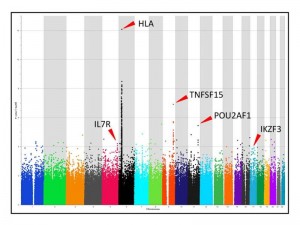New risk genes identified for intractable liver disease Fourteen risk genes including two new risk loci found

Primary biliary cirrhosis is a cholestatic liver disease of unknown cause that affects primarily middle-aged women. There are relatively few patients in Japan (estimated at 50,000 to 60,000), but as the disease progresses it leads to jaundice and liver failure. There is currently no cure other than a life-saving liver transplant.

Genome-wide search for genetic factors for intractable liver (primary biliary cirrhosis). © Minoru Nakamura
In addition to the newly-discovered risk genes TNFSF15 and POU2AF1, risk genes including HLA, IL7R and IKZF3 reported in studies of European and US populations were also identified.
It has been suggested that there is a strong genetic contribution to the pathogenesis of this disease, and 21 risk genes have already been identified in studies of European and US populations. Identifying whether these risk genes are common across human populations affected by this disease is important for elucidating disease pathogenesis, but is also an important issue in human genetics for elucidating the association between disease and human evolution. Researchers around the world are particularly interested in the outcome of this research into the identification of disease risk genes in a population of relatively high genetic homogeneity.
A nationwide liver disease joint research group lead by Professor Minoru Nakamura (Nagasaki University Graduate School of Biomedical Sciences; Nagasaki Medical Center/Clinical Research Center, Visiting Researcher), and including Professor Katsushi Tokunaga (University of Tokyo Graduate School of Medicine Department of Human Genetics), carried out a genome-wide association study (GWAS) on DNA samples from 1,500 patients with primary biliary cirrhosis and 1,200 healthy individuals. The group identified two new risk genes associated with primary biliary cirrhosis, in addition to more than ten risk genes identified in prior studies with European and American populations.
The two new risk genes identified in this study, TNFSF15 and POU2AF1, play important roles in the differentiation and maturation of immune cells including B lymphocytes and T lymphocytes. It has been shown that individual differences in these genes (gene polymorphism) are involved in the pathogenesis of primary biliary cirrhosis in the Japanese population. The results of this research suggest that while there are differences in risk genes across different populations, there is a common pathway in the disease onset.
The identification of these risk genes is a major step forward in the development of treatments and a cure for primary biliary cirrhosis.
Press release (Japanese) [PDF]
Paper
Minoru Nakamura, Nao Nishida, Minae Kawashima, et al.,
“Genome-wide association study identifies TNFSF15 and POU2AF1 as susceptibility loci for primary biliary cirrhosis”,
American Journal of Human Genetics Online Edition: 2012/09/21 (Japan time), doi: 10.1016/j.ajhg.
Article link






